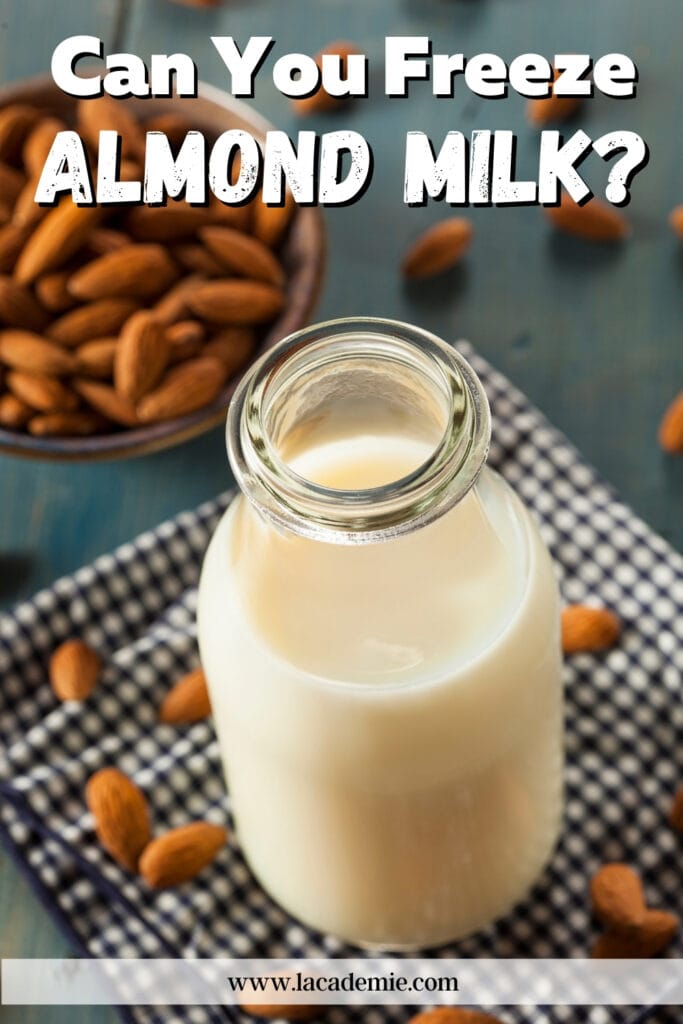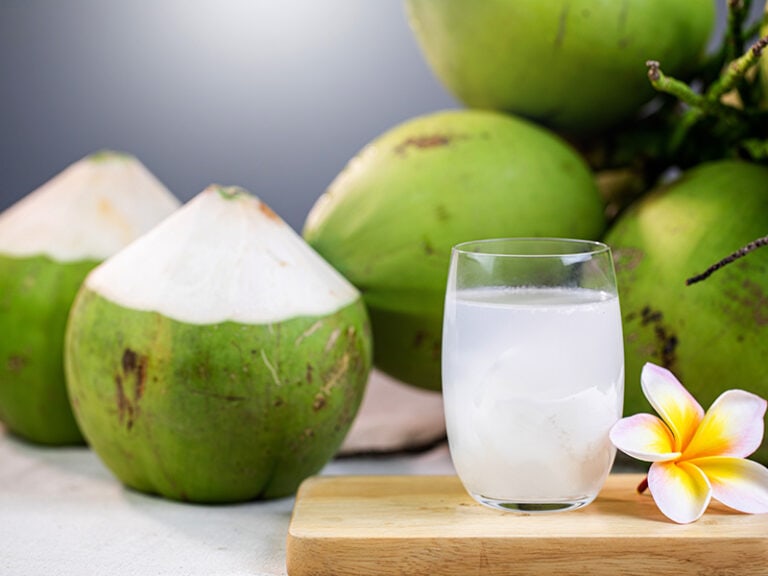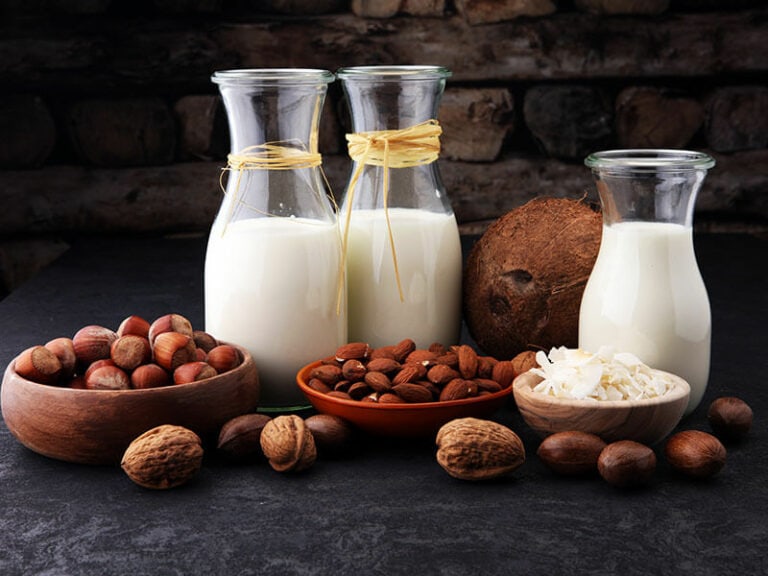Many of us wonder if we can freeze our favorite almond milk. Do you worry that the nutritional content and taste of almond milk will change dramatically after defrosting?
Since current almond milk products usually only have a shelf life of about a week after opening, you are concerned about storing them in the freezer. It’s okay; my article below will answer all your questions.
This article includes my comprehensive guide to help you freeze, defrost, preserve and use your almond milk the right way. Therefore, do not skip this article if you want to find the correct answer for yourself!

What Is Almond Milk?
Almond milk is a product from an almond seed. Almonds are a type of nut that has a lot of benefits for everyone’s health. This is used to prepare delicious dishes and suitable for many people of different ages.
This is a prevalent type of milk, especially plant-based ones. Basically, almond milk is water made from almonds ground with water, mixed with water.
It resembles regular milk that has a creamy texture and nutty flavor. The almond milk has a light, creamy, creamy taste and a lovely milky white color.
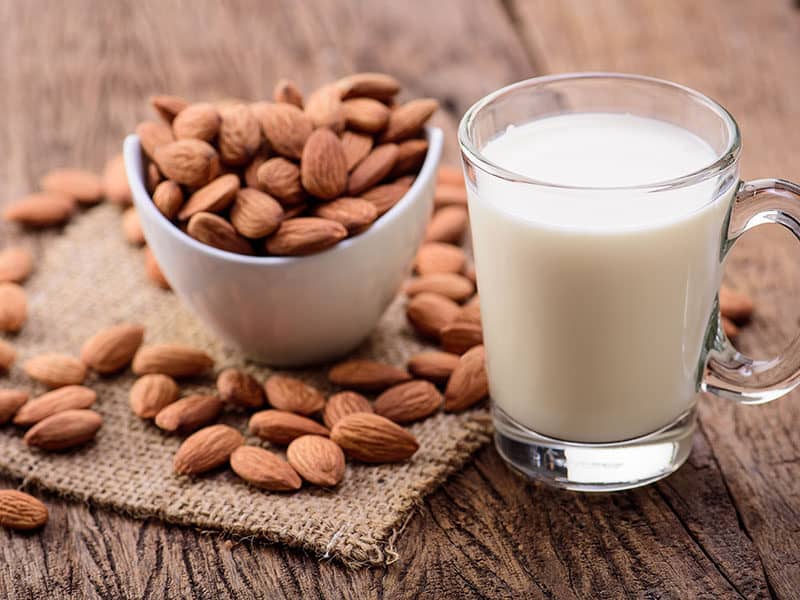
You can find almond milk at most supermarkets, often in health food stalls. Almond milk on the market comes from many brands with different flavors. So read the label carefully to decide whether your milk fits with gluten-free diets or other diets.
Furthermore, almond milk is also very easy to make at home by grinding almond seeds or using the finest almond flour on the market. Whether homemade or store-bought, the soft texture of the almond milk makes it a favorite in the kitchen.
Almond milk is not as high in glycemic as rice milk, nor does it have hormone or GMO disorders like soy milk, fewer calories than cow’s milk, and no cholesterol, but more protein. For this reason, it is a fairly popular choice for vegans with allergies or intolerances to animal milk.
The History Of Almond Milk
Almond milk has emerged in the past few years, said Jenny Heap, a nutritionist at the Almond Council of California. In fact, it has been around since the Middle Ages, when wealthy families preferred the drink to milk from animals.
But in the last five years, it has become a trend and has been on the stalls selling frozen milk alongside ice cream and other products. In 2014, the Boston Globe reported that almond milk overtook soy milk as the most popular non-animal dairy product.
The Benefits Of Almond Milk
Let me show you some of the excellent benefits that almond milk brings to our health:
Safe And Hypoallergenic
Consuming other kinds of milk like soy milk, you may worry because genetically modified soybeans have a negative effect on health, or fresh milk containing a lot of saturated fatty acids can cause the skin to secrete more oil, causing acne.
However, almond milk is very safe. No matter what variety of almond your milk is made from, you have complete peace of mind that it is neither genetically modified nor saturated with fatty acids.
Almond milk doesn’t contain cow’s milk as well as other animal products but only almond powder mixed with water. This makes it one of the best options to go with cereal products for vegans. People who are intolerant or allergic to milk can also drink this beverage.
Lactose-Free
Besides, many people are lactose intolerant and cannot fully digest it. Undigested lactose passes through the colon, where it is fermented by many of the microorganisms that reside there, leading to gas, diarrhea, and associated discomfort.
Since they do not contain animal milk, they are lactose-free, making them suitable for lactose allergies. Almond milk is hypoallergenic, so it is one of the products that doctors recommend as a substitute for raw milk if you have a milk allergy.
Low-Carb
Unsweetened almond milk is a low-carb drink. They are also high in protein and other nutrients, equivalent to carb content. For this reason, it does not raise blood sugar, and suitable for people with diabetes, as well as on low-carb diets.
Since almond milk is easy to digest, low in fat, and low in sugar, it is an excellent drink for people looking to lose weight while still needing a sufficient supply of nutrients.
Low Calories
Commercial almond milk is low in calories. This means you can drink a lot without worrying about gaining weight. It provides relatively many nutrients compared to the number of calories it provides. Manufacturers often dilute with water so that this milk’s fat content is comparable to that of low-fat milk.
Nutritious
You may think that almond milk is not as nutritious as cow’s milk, but many brands add nutritional supplements for the best content. They add many nutrients to give almond milk the same nutritional value as cow’s milk.
In addition, almond milk also helps prevent and improve diseases such as cancer and related lifestyle diseases.
Rich In Vitamin D
We always look for a good sources of vitamin D in everyday in our diets, but not many found. Almond milk is a particular food source that meets our needs of vitamin D.
When you consume vitamin D enriched almond milk regularly, it can prevent vitamin D deficiencies in your diets.
Rich In Vitamin E
Studies show that regular almond consumption can reduce heart disease risk because almond milk is high in vitamin E and healthy fats.
As you may know, vitamin E has antioxidant effects that help prevent the aging of the body. Compared to other vitamin E-rich foods, almond milk ranked first.
It also works well for the eyes, prevents and improves freckles, wrinkles on the skin. This milk is believed to be effective against UV rays.
Promote Bone Health
Calcium supplements are often required by manufacturers. If you drink a cup of almond milk everyday, you will gain the necessary amount of calcium for a day.
Therefore, almond milk is a good calcium supplement source, especially for who do not use dairy product such as cow’s milk.
So, Can You Freeze Almond Milk?
Since almond milk is so healthy, many people will want to freeze almond milk in their refrigerators for regular and prolonged use. However, should almond milk be frozen?
To be honest, most manufacturers do not recommend freeze almond milk. The reason is that almond milk, when freeze in the freezer, undergoes biochemical changes.
These changes will affect the texture, color, and flavor of the almond milk. This will involve more or less the characteristics of the product. However, you can rest assured that it won’t affect the nutritional content of your almond milk.
So I’ll give you a few ways to minimize adverse effects and deliver positive experiences. This way, you can preserve the excellent value of the almond milk even after freezing it. That is, you can freeze it at will if the need arises!
Proper Ways To Freeze Almond Milk
Let’s go to the central part together! There are many ways to freeze almond milk, and in this article, I will cover the three that I think are the most convenient. Please continue reading to decide which options are more beneficial for your situation.
Method 1: Freeze Almond Milk In An Ice Cube Tray
Freezing the almond milk in pieces will take more work, but these ice cubes will allow you to defrost properly.
If you want to freeze the almond milk in this way, simply follow these steps:
- Prepare a tray of ice cubes.
- Pour the almond milk from the box/bottle into the ice tray.
- Then, gently place an ice cube tray filled with almond milk in the freezer.
- Wait for the almond milk in the ice cube tray to solidify (about a few hours).
- Remove the almond milk blocks from the ice tray.
- Continue to put the cubes in the bag or container in the freezer.
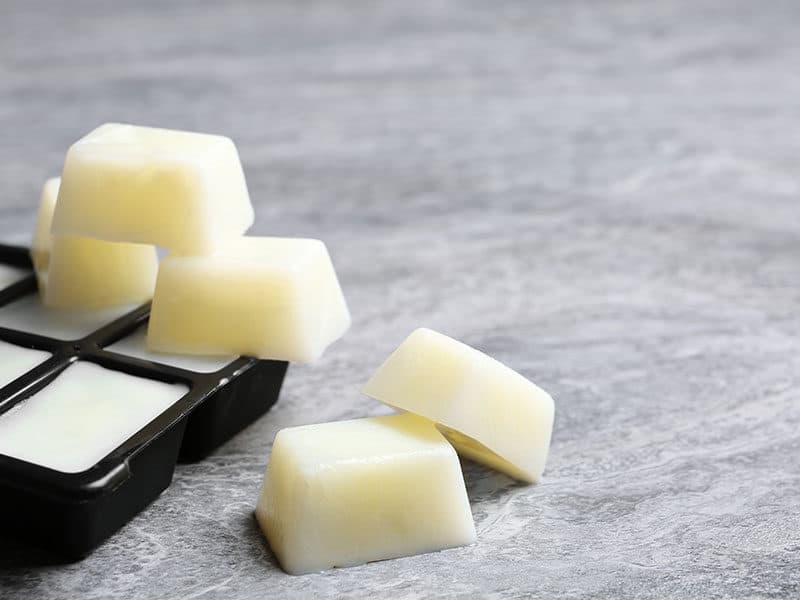
Bonus Tips:
- When pouring almond milk into the ice tray, make sure to pour it moderately, not too full because the almond milk contains a lot of water, but the water tends to expand and spill out after it froze.
- You can leave the almond milk in an ice tray in the freezer overnight. Then the next morning, you should have fully frozen almond milk cubes.
- You should act quickly when taking out the almond milk ice cubes because the finger’s warmth if exposed for a long time, will melt the milk.
- If using a freezer bag to contain the almond milk ice cubes, make sure you squeeze out all of the air before sealing the top.
- You can attach a date stamp to a bag or carrying case if you have a bad memory.
- To know how many almond milk ice cubes need to defrost, try measuring the volume of a single piece to find out how many are suitable for your recipe.
Pros Of This Method:
Freezing almond milk in small cubes like the block in an ice tray will help you defrost more easily, depending on your needs. Almond ice cubes will be the perfect choice for your morning nutrient water recipe.
Cons Of This Method:
Dividing almond milk into small boxes will be a bit more difficult and time-consuming. The same goes for removing the frozen milk ice cubes from the tray afterward.
Method 2: Freeze Almond Milk In The Milk Storage Bag
This is an interesting method because you will be able to see how much almond milk you freeze. Since there are volume markers on each baby milk bag, you can take advantage of this feature to determine the exact volume of almond milk you need to defrost each time for your recipe.
If you choose to freeze almond milk in this manner, you will need:
- Prepare suitable sized milk storage bags (or make use of your baby’s).
- Pour almond milk from boxes/bottles into milk storage bags.
- Then, arrange the milk storage bags filled with almond milk in the refrigerator freezer.
- Wait for the almond milk in the storage bags to solidify (depending on the volume).
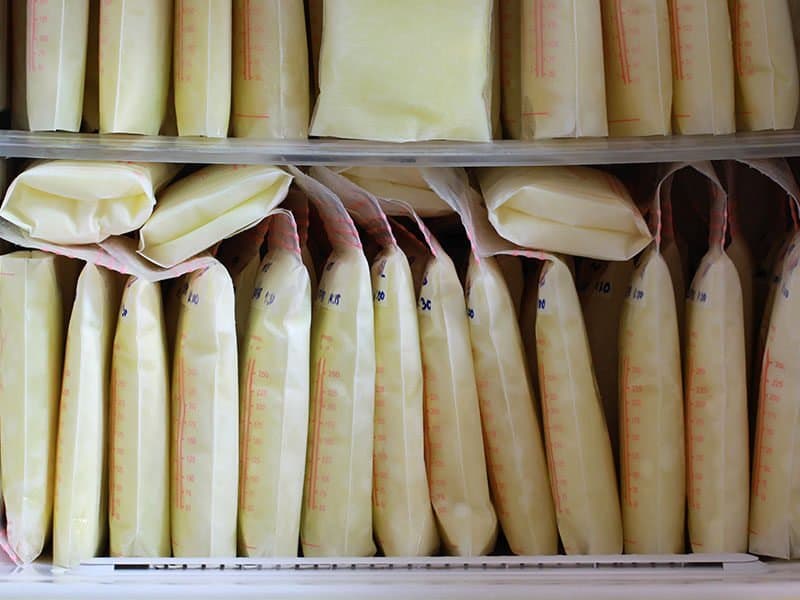
Bonus Tips:
- Research what you will use defrosted almond milk for. From there, you know how much you have to choose storage bags with
- Ensure you only fill in a moderate amount and allow some room before sealing the bag to prevent the milk from spilling and spilling out after it thickens.
- You can keep the almond milk in the storage bag in the freezer until you need to defrost it without removing it from the bag or doing anything.
- You can attach a date label to each milk bag to make sure you use it in time.
Pros Of This Method:
Freezing almond milk in each storage bag will make it easier to defrost right in the bag. It is also the right choice for formulas that require the correct milk dosage due to the volume index printed on the bag.
Cons Of This Method:
Dividing the almond milk into each bag will likely spill out more easily and take a little longer. Milk is also at risk of breaking the bag after it is frozen. Furthermore, plastic bags are not an environmentally friendly option.
Method 3: Freeze Almond Milk In The Container
If you’re fumbling with the previous freezing methods, this canister method with freezer-compatible containers is even simpler. It doesn’t even take a bit of your effort and time. You will:
- Prepare one or more equipped containers with an airtight lid.
- Pour almond milk into the container.
- Place the containers in the freezer.
Bonus Tips:
- Make sure that the container is upright until the liquid solidifies.
- If you already know how you will use milk, pour the required amount of liquid for one dish into each dish. This way, after defrosting the container, you can continue.
- Make sure there is some headspace in each container as the milk will expand after freezing.
- Again, if needed, add labels for each one.
- You should not choose a glass box as it is not good for placing in the freezer.
Pros Of This Method:
This is the best method to freeze large amounts of almond milk. You don’t have to waste time dividing the milk into small cubes and removing each ice cube after the milk curd. This is also a better option if you predetermine how you will use the almond milk after defrosting.
Cons Of This Method:
One way to defrost, you will have to defrost all the almond milk in the container. That means you have to use up all of this milk in one go.
Which Freezing Method Should You Choose For Your Almond Milk?
The two methods sounded equally good. However, there are a few things you should consider to choose the right method for you. The way to not make a mistake is to consider your portion sizes. Now is the time to think about how you will consume the defrosted almond drink.
If you know how you will use your almond milk right after defrosting, and that’s a lot of milk, then it’s best to use a container. Since using the container means you will defrost all the almond milk in it, make sure to use it all up.
If you are not sure what your diet will look like and when you need to prepare it, freezing milk into cubes in an ice cube tray will be a smart choice. If you’re not sure you’ll use it right after defrosting, individual ice cubes will be more flexible to use.
Properly Ways To Defrost Frozen Almond Milk
Now that you know how to freeze almond milk properly, now is the time to learn about defrosting properly. There are many ways to defrost milk depending on convenience, personal preferences, and the time you want to invest. Some of the most popular ways are:
Method 1: Defrosting In The Cool Refrigerator Compartment
This is the method I recommend that you use, which is to transfer the frozen almond milk from the freezer to the cool compartment for a few hours to defrost slowly. Although this method takes quite a while, it is the safest method.
The reason I recommend this method is because it allows gradual changes of temperature, not too sudden. As a result, the ice crystals can slowly melt, thanks to which it also rationally combines with the solid content of the almond milk without dissociation.
While the wait time will be longer than other defrosting methods, you will find it truly worthwhile to bring you the best-defrosted almond milk in both flavor, color, and texture.
Bonus Tips:
- You can transfer the frozen almond milk to the refrigerator cool compartment in the evening, and it will completely melt in the morning.
- It’s a good idea to consider the defrost time to keep up with your plan, as larger containers will require more time.
Method 2: Defrosting Using The Defrosting Tray
There are various benefits using the right defrosting tray to defrost any food, and almond milk is no exception. That’s because the thawing tray is made of a highly thermally conductive material that will help you defrost almond milk safely and quickly.
Compared with natural defrosting, defrosting almond milk in the defrosting tray can be twice as fast.
At the same time, your frozen almond milk is defrosted more uniformly, not patchy. Furthermore, defrosting trays are also a defrosting method that is certified as safe food.
Bonus Tips:
Since the defrosting tray is so compact, you can put it in the corner of your kitchen cabinets and just wait.
Method 3: Defrosted In Cool Water
Use this method only when you need to defrost almond milk urgently. Place the frozen almond milk in the bag or container in a water tub to speed the process. Since water especially conducts heat better than air, defrosting your milk will be accelerated.
Bonus Tips:
- You should not use warm water. Cool water is best for keeping almond milk safe and effective defrosting.
- Make sure your bag or container is completely sealed and doesn’t leak before you put it in the water; otherwise, everything will spoil.
Method 4: Defrosting On The Stove
If your goal is to use frozen almond milk in dishes or drinks that need to be cooked on the stove, this is a good opportunity. You just need to add the block of milk to what you’re cooking and defrost it right on the stove.
Bonus Tips:
Stir well to dissolve the milk completely into your food or drink.
General Notes:
- Do not defrost at room temperature, as this will deteriorate the separation of liquids and solids.
- Whatever method you use, shake well after the frozen almond milk has completely defrosted. That helps the almond solids and the liquid to blend together completely.
- Once the almond milk is defrosted, use it immediately as possible, or at most within a day or two.
How To Use Defrosted Almond Milk
Just like milk, almond milk has a variety of uses. This depends on what your needs are. If you are not sure what to use frozen almond milk for or after defrosting, here are some ways to go:
- Add to coffee or turmeric tea
- Mix with a smoothie or make a milkshake
- Eat with cereal instead of cow’s milk
- Make pudding or non-dairy cream
- Use in soups, sauces, or salad dressings
- A substitute for cow’s milk in baked goods
- Use as a condiment for cooked dishes
Things To Consider When Freezing Almond Milk
Although frozen almond milk may somewhat extend its shelf life by a few days, some almond milk manufacturers disagree with you freezing their products.
They want you to consume their product at the best timing and texture, but freezing milk will change a bit of them. And you should know these changes to decide.
Affects Texture, Consistency, And Color
To be honest, the freezing and defrosting process will harm the texture, color, and consistency of the almond milk. The water content in the almond milk is frozen into ice crystals, disrupting the product’s structure.
During freezing, the main ingredient of almond milk is the fine almond powder particles separated from the water. This becomes most obvious and noticeable after you defrost frozen almond milk and pour it into a glass. The solid part will be completely separated from the water component, and the milk will no longer look attractive.
Separation of liquids and solids in almond milk, while not affecting the safety and nutritional content, can also significantly affect the consistency, color, and taste of the product after defrosting.
Affect The Shelf Life
When almond milk is frozen then defrosted, do you think it will have a longer shelf life? No, the expiration can only be extended for a few days while it is still frozen. Once defrosted, the product’s shelf life is even shorter than if you just open the packaging and keep it in the cooler compartment.
Normally, almond milk after opening can be stored in the refrigerator cooler for about a week or more, for 7 to 10 days. However, once frozen and defrosted, almond milk can only be consumed for best for 2 to 4 days.
How To Avoid Freezing Almond Milk
Since there are always undesirable changes that can affect almond milk when it is frozen then defrosted, freezing almond milk is often seen as a reluctant and final option to extend the shelf life for a few days. Please remember the following to avoid freeze almond milk:
Notice The Expiry Date:
If you buy store-bought almond milk, most will have a shelf life of at least a few months. Unless you have your own reasons and don’t use it before its expiration date, freezing almond milk usually makes no sense if you haven’t opened the packaging.
Therefore, you should carefully check the almond milk label to see when the expiry date is right for your needs. This will help you ensure that the product is consumed at optimum freshness and safety without freezing it.
Have you missed the expiry date for a few days? That doesn’t mean you have to put it in the freezer. Sometimes some almond milk is safe to consume a few days or even weeks after its expiration date if stored properly in the refrigerator cooler.
Proper Storage
Proper storage of almond milk will help you always enjoy the full flavor of the almond milk as well as maximize the absorption of the nutrients contained in this nut milk.
Furthermore, if stored improperly, you may accidentally use spoiled almond milk. That will seriously harm the health of you and your loved one. Even if the almond milk has been fermented, altered, and produced toxins, you can be poisoned.
Some brands allow their almond milk to be stored at room temperature without opening the lid. However, others will require you to refrigerate even without opening the lid. Therefore, you should carefully check the manufacturer’s recommendations for proper storage.
Unopened almond milk will last a long time because it has not been exposed to the air. However, once you open the can, you understand that the almond milk shelf life will be greatly reduced, to only 7 to 10 days, as I said.
Therefore, you should consume all of the almond milk in the can during this time. And it is best to check for signs of spoilage carefully before gulping to avoid stomach pain and vomiting.
Signs To Recognize Spoiled Almond Milk
As I mentioned above, frozen almond milk can spoil more quickly after defrosting than when stored in the refrigerator cooler. Once the quality has declined, the almond milk will no longer be safe for your health.

So, check for signs that almond milk is spoiled and is no longer suitable for consumption:
Variable Texture And Consistency
First, you must check the texture and consistency of the almond milk after defrosting. If it appears to be lumpy, form greasy, or slimy, get rid of it.
Damaged almond milk can become thick, so you can try pouring some milk into a cup or sink. If the milk flow when you spill is not flowing as smoothly and thin as usual, it means your almond milk is spoiled.
Unpleasant Smell
Once the almond milk was spoiled, bacteria formed and attacked. And bacteria are sure to carry a bad smell. Rotten almond milk usually has a sour smell. If you smell it, say goodbye to it.
Strange Taste
Tasting it is one of the fastest ways to know if your almond milk is spoiled or not. You can add a few drops to the spoon and taste it very little (don’t take a sip!). The weird, unpleasant taste plus the sour taste are the strongest signs that you should throw it away.
Questions Regarding the Freezing Of Almond Milk
Here are some common questions regarding almond milk freezing that you may ask. I will help you find the answer.
Wrap It Up
Well, the final answer is that you can freeze almond milk. Effects and changes in flavor, texture, and color will occur more or less, but that is still acceptable since milk’s nutritional content does not change.
I hope the rich and helpful information in this guide will help you answer any questions about freezing almond milk. And if this article was helpful to you, don’t forget to share it with other people who have the same question.
Feel free to leave a comment if you have any questions, and I will get back to you.
